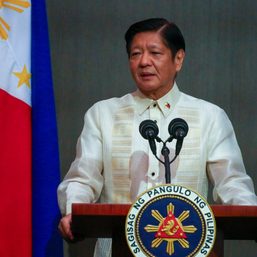SUMMARY
This is AI generated summarization, which may have errors. For context, always refer to the full article.

MANILA, Philippines – The consortium led by Ramon Ang’s San Miguel Corporation is set to take over and rehabilitate Manila’s aging airport by September 2024. And it seems that passengers will soon have to pay modernization’s heavy price with higher terminal fees and ticket prices.
Currently, passengers are required to pay a passenger service charge, also known as a terminal fee, of P200 for domestic trips and P550 for international trips. But with the looming privatization of the Ninoy Aquino International Airport (NAIA), the Department of Transportation (DOTr) has confirmed a proposal to raise the terminal fee for international trips to P950 starting in 2025. This represents a 72.7% hike.
As early as February 2024, when a winning bidder for the airport was first announced, the government already said that a rate hike for “rentals, navigational charges,” and other fees was on the table. Now, it seems likely that the big-time hike will include terminal fees.
“Magkakaroon ng increase kasi, alam mo, kailangan namang ma-compensate natin ‘yung concessionaire doon sa investments na gagawin nila,” Transportation Secretary Jaime Bautista said in a press conference on Friday, July 5.
(There will be an increase because, you know, the concessionaire will have to be compensated for the investments that it will put in.)
The proposed terminal fee hike is still subject to approval by the Cabinet. Bautista also said it will still be reviewed by a committee composed of representatives from seven government agencies, including the DOTr, Department of Finance, and National Economic and Development Authority.
Aside from higher terminal fees, the proposal also seeks to increase airport charges – such as landing, takeoff, and parking fees – before the end of 2024. Unlike terminal fees, these aren’t directly charged to passengers. But airlines may still pass on the extra costs to their customers by raising ticket prices.
“Determining the fare is really up to the airline,” Bautista said in a mix of English and Filipino. “DOTr has no say when it comes to raising fares. It’s the call of the airline.”
The proposed hike for landing and takeoff fees will be quite large, according to Bautista, although he did not disclose the exact amount.
“’Yung landing and takeoff fees, ‘yung recommendation ay medyo mataas, although hindi siya naman major expense ng mga airlines (The recommendation for the landing and takeoff fees is quite big, although it’s not a major expense for airlines),” he said. “But we’re working with the airlines on this.”
However, aviation groups such as the Air Carriers Association of the Philippines have fiercely opposed the rate hike. The groups wrote in a letter to Bautista that the proposal would make NAIA among the most expensive airports in the region and be “detrimental to a majority of the Filipino traveling public at a time when costs throughout are rising,” according to a report by the Philippine Daily Inquirer.
Bautista defended the big-time hike by pointing out that NAIA has not raised fees for 24 years. He also compared NAIA’s P550 international terminal fee to the relatively higher P750 terminal fee at both the Mactan-Cebu International Airport and Clark International Airport – two award-winning airports developed through public-private partnership agreements.
The transportation secretary maintained that the improvements which NAIA’s private operator can make will be worth the higher fees.
“With the investments that they will do using the charges that they will collect, the airport’s efficiency will improve from the current 32 million capacity to 60 to 62 million. And that would mean a more comfortable and better experience for passengers,” Bautista said in a mix of English and Filipino.
By the fourth quarter of 2024, the New NAIA Infrastructure Corporation is expected to take over operations at the airport. The private operator will be required to upgrade the airport’s facilities, raise its maximum annual capacity to 62 million, and improve air traffic movements per hour from 40 to 48. (READ: NAIA Terminal 5? Ramon Ang bares plans for Philippines’ main airport)
Under the bid terms, San Miguel’s group will share 82.16% of its gross revenue with the government, on top of an upfront payment of P30 billion and a fixed annual payment of P2 billion. – Rappler.com
Add a comment
How does this make you feel?


![[OPINION] Clark International Airport, one of world’s most beautiful airports, is badly underutilized](https://www.rappler.com/tachyon/2024/05/clark-airport-underutilized-may-28-2024.jpg?resize=257%2C257&crop=560px%2C0px%2C720px%2C720px)





There are no comments yet. Add your comment to start the conversation.